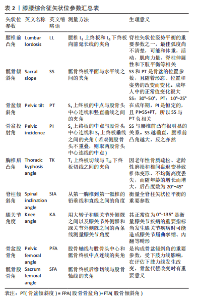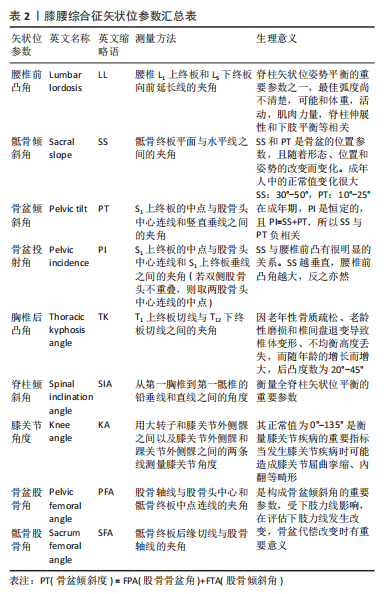Chinese Journal of Tissue Engineering Research ›› 2023, Vol. 27 ›› Issue (29): 4751-4756.doi: 10.12307/2023.626
Measurement research method and measurement equipment for knee-spine syndrome
Yang Qiang1, Huang Jian2
- 1Inner Mongolia Medical University, Hohhot 010110, Inner Mongolia Autonomous Region, China; 2The Second Affiliated Hospital of Inner Mongolia Medical University, Hohhot 010000, Inner Mongolia Autonomous Region, China
-
Received:2022-06-08Accepted:2022-08-18Online:2023-10-18Published:2022-12-02 -
Contact:Huang Jian, Professor, The Second Affiliated Hospital of Inner Mongolia Medical University, Hohhot 010000, Inner Mongolia Autonomous Region, China -
About author:Yang Qiang, Master candidate, Inner Mongolia Medical University, Hohhot 010110, Inner Mongolia Autonomous Region, China -
Supported by:Science and Technology Project of Inner Mongolia Autonomous Region, No. 2021GG0194 (to HJ)
CLC Number:
Cite this article
Yang Qiang, Huang Jian. Measurement research method and measurement equipment for knee-spine syndrome[J]. Chinese Journal of Tissue Engineering Research, 2023, 27(29): 4751-4756.
share this article
Add to citation manager EndNote|Reference Manager|ProCite|BibTeX|RefWorks

2.1 膝腰综合征的起源 在2002年,日本名古屋大学医学部学者TSUJI首次描述了膝腰综合征。在一项社区普查的研究中,随机选取纳入156名[(66.6±6.3)岁,男性68.2岁,女性66.3岁]无明显膝关节骨性关节炎的受试对象,发现下腰痛和膝前痛之间存在显著的相关性。此前OFFIERSKI和MACNAB[10]就探究过脊柱矢状位对位与髋关节疼痛之间的相关性,并将其定义为髋-腰综合征,受此启发TSUJI等[1]将这种腰椎前凸角、骶骨倾斜角的减小与膝关节屈曲角度增大之间的显著相关性称为膝腰综合征。此后,拉开了膝关节与腰椎矢状为对位之间关系的研究的崭新帷幕。随后,2003年日本千叶大学学者MURATA等[11]筛查了365例膝关节痛和(或)下腰痛患者,分别测量了骶骨倾斜角、膝关节屈曲度及腰椎前凸角,表明膝关节的退行性屈曲改变可能是腰椎脊柱前凸角丧失变化的一个因素,并将这种相关性也定义为膝腰综合征。 中国学者在早期也同样关注这一新兴概念并给予研究,黄健教授等[12]对行全膝人工关节置换术的患者进行了长期的随访研究,发现成功的膝关节置换后可能出现腰椎症状或原有症状加重的情况,并用膝腰综合征的理论进行探讨及剖析,指出在矫正下肢屈曲挛缩畸形后腰椎的生理曲度逐渐恢复如前,腰椎前凸角增大,使得具有姿势依赖性的腰椎管容积相对减小[13-14],进而可能出现腰椎症状或原有症状加重的现象,为临床医师进行医疗决策,提供了指导及理论依据。 膝腰综合征这一概念逐渐进入世界众多研究者的视野之中,也一度成为关节科、脊柱科、矫形科临床工作医师的研究热点,其内在机制对解读整个人体的力线构成、相互代偿变化及各种临床现象的发生具有重要意义[15-45]。膝腰综合征的研究历程,见表1。"
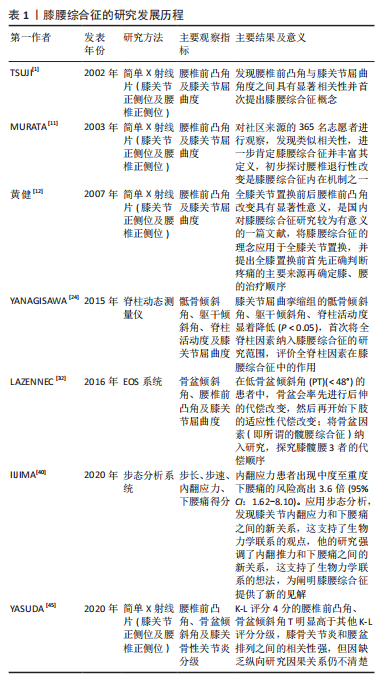
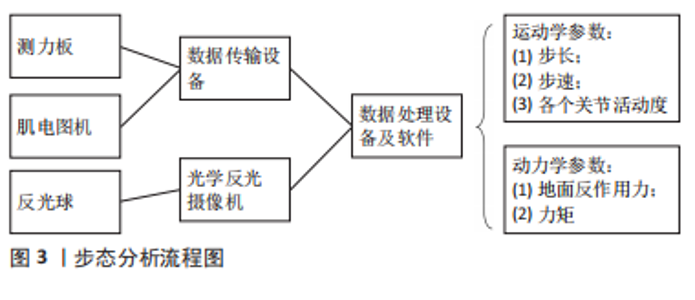
目前的很多研究认为膝关节屈曲度与腰椎前凸角呈负相关,即膝关节屈曲度愈大,腰椎前凸角愈小。刘飞等[19]收集正常人64例和骨关节炎患者62例的站立位全脊柱侧位X射线平片并测量各腰椎及骨盆参数,发现膝关节屈曲明显的骨关节炎患者,其脊柱和骨盆参数均发生有显著性差异的改变;值得注意的是;在该研究中骨盆投射角(pelvic incidence,PI)较对照组增大、骶骨股骨角(sacrum femoral angle,SFA)和骨盆股骨角 (pelvic femoral angle,PFA)较对照组减小,这表明膝关节的屈曲挛缩畸形不仅可以导致腰椎矢状位排列异常,还影响着骨盆与股骨的矢状位排列,但对于髋、脊柱的先后变化未进一步进行说明。LEE等[20]不同于以往研究,设计全新的研究方法探究膝关节屈曲度与腰椎矢状对位之间的关系,以期明确在正常人群中脊柱和骨盆对膝关节屈曲的代偿性反应方式及反应的先后顺序。该研究选取30名平均年龄为30.4岁(26-37岁)的年轻男性志愿者,双侧膝盖上戴上运动控制的膝关节支架,这种支架可以模拟两种不同的膝关节屈曲角度15°和30°,然后分析各膝关节屈曲角度下的腰椎X射线片,结果发现膝关节屈曲对骨盆各参数没有明显的影响,但可以导致腰椎前凸角的减小和上身矢状面平衡的前移,这表明当膝关节屈曲发生时腰椎会首先出现代偿反应从而保持平衡,并解释原因可能是相比之下,腰椎的活动度大故而反应较为迅速且灵敏,骨盆的活动度较腰椎要小得多,故而改变较小且迟缓。该研究证明了膝腰之间的相互联系性,存在相互代偿改变;然而此研究尚存在局限性,实验不能确定是否能够反映真实的病理情况,因为长期以往的膝关节屈曲挛缩畸形是不能被模拟的。 此后国内外的学者利用简单X射线平片的研究方法已经延续数年[21-22],通过测量简单的X射线片上各种矢状位角度进而研究膝腰综合征的方法已经不能满足膝腰综合征的发展需要,因为局部的X射线片检查不能提供同一瞬时情况下的其他部位的代偿反应。X射线平片的优势在于摄片方式简便、快捷、价格低廉,并且对于后期测量操作来说也是十分简单,在衡量各种角度、构建力线方面也是体现出不俗的优势。同样的其缺点也较为明显,整个拍摄过程为静态测量、获得的也仅是局部图像并且受拍摄者的体位影响较大,易产生误差,影响实验的准确性。最后,对于诸如此类此类静态且局部的参数测量的研究来说,已经不足以支撑膝腰综合征的发展及进步,新设备、新理念的诞生为这一研究领域带来了全新的研究视野。 2.2.2 脊柱动态测量法(The Spinal Mouse) 2015年日本学者TAUCHI 等[23]利用脊柱动态测量仪对全脊柱活动度等指标作出测量,并进一步推测膝关节骨性关节炎与全脊柱倾斜角度具有相关性,但不确定哪个因素先出现。提出2种膝、腰之间的代偿机制,一方面,对于脊柱倾斜角度增加、头部向前弯曲和矢状面失衡的老年人,他们必须保持髋关节和膝关节的屈曲,以保持他们的矢状面平衡从而稳定地站立,这时膝关节在弯曲的位置会变得过载,这种持续的过载导致膝关节骨性关节炎的发生,这可以被称为脊柱-膝关节综合征。另一方面,如果一个老年人先有膝关节骨性关节炎的发生,站立位时膝关节屈曲挛缩畸形,致使重心前移,长久屈膝卑躬姿态,造成腰椎小关节突的应力集中,加速骨赘增生,使得脊柱矢状位失衡,这可以被称为膝关节-脊柱综合征,这为进一步研究这个问题奠定了基础,首次证明了全脊柱因素与膝关节骨性关节炎之间的联系性。同年YANAGISAWA等[24]利用脊柱动态测量仪对246名山区村民进行大规模横断面调查,得出膝腰之间具有强相关性的结论,然而两者之间的主导关系还是不能确定。 此前的多项研究可以证明脊柱动态测量仪的可靠性[25-28],脊柱动态测量仪的应用使全脊柱因素纳入膝腰综合征的研究范畴,为膝腰综合征的研究提供了新的研究角度。虽然脊柱动态测量仪是一款廉价、快捷的测量手段,但是利用它可以获得全脊柱活动度、分析全脊柱力线的整体变化。这是简单X射线平片所不具备的,同理若分析其缺点,那便是利用脊柱测量仪这类计算机辅助工具来测量脊柱变化,获得的仅仅是较为粗略的整体变化数据,对于脊柱内部各节段的变化,不能较为细致且真实地反映代偿情况。 2.2.3 EOS测量法 近些年脊柱矢状位的失衡或者也可以说是矢状位对位不良逐渐成为研究热点,其代偿机制的研究也多集中于骨盆和髋关节[29],对下肢的研究较少[30],因为此类研究要求获得同一时间状态下的腰椎及下肢的X射线片,EOS系统的诞生为解决这一问题带来希望。EOS系统可以提供患者负重状态下功能位的三维立体成像,最重要的是图像可以在无拼接和放大失真的情况下获得全身的负重位图像,更好地可视化脊柱、髋关节和膝关节三者之间的相互代偿[31]。LAZENNEC等[32]将EOS系统应用于腰椎管狭窄患者的研究,其中通过对站立位及坐位的EOS图像分析,证明了下肢对腰椎矢状位平衡的重要代偿作用;强调了对于存在腰椎管狭窄合并下肢病变的髋-腰、膝-腰综合征患者行EOS检测、进行整体评估的必要性;探讨了骨盆和下肢代偿现象的出现时间和先后分布的问题,认为在低骨盆倾斜角(PT< 48°)的患者中,骨盆会率先进行后伸的代偿改变,然后再开始下肢的适应性代偿改变。 对于正常和高倾斜角的情况,骨盆伸展的代偿储备较大,但在大多数情况下,站立位时骨盆伸展代偿能力是并不能全部发挥的。有研究对28例存在严重脊柱畸形的患者进行了研究,并应用EOS系统测量获得各脊柱和骨盆参数以及同一时间状态下的膝关节屈曲角度,然后进行了不同测量参数之间的相关性分析,结果提示:腰椎前凸角与骶骨倾斜角、膝关节屈曲角度相关[33];骨盆倾斜与膝关节屈曲角度中度相关(r=0.55),其中腰椎前凸角与膝关节屈曲角度拥有最好相关性。对脊柱存在畸形的患者进行研究,是较为新颖的出发点,对膝腰之间的相互联系给予新的证据;脊柱的正常矢状位排列是骨盆、脊柱和下肢之间相互代偿平衡的结果。膝关节屈曲畸形可以作为腰椎矢状面不平衡的一种代偿机制,因而在行全膝关节置换或其他可以改变下肢力线的手术时应充分考虑对髋、脊柱的影响,进一步完善手术细节及临床决策。 通过EOS系统,研究者们在低剂量辐射下就可以获得实时的站立位和坐位患者的整体图像并且通过后处理软件,还可以获得无拼接、无放大失真的负重状态下人体三维立体成像,为分析脊柱平衡和下肢代偿并进一步设计、优化手术策略提供了新的研究工具[34]。但是对于膝腰综合征的发展来说,此类瞬时图像的作用虽然极为重要,但是没能在运动体系中探究膝、腰两者的代偿变化,并且EOS系统的构建,需要较大的财力、物力的投入,目前尚未在中国医院形成普及。 2.2.4 有限元分析法 1972年BELYTSCHKO等将有限元分析应用于脊柱力学研究,目前的有限元分析可对椎体、椎间盘、关节突和椎旁肌肉韧带等进行建模研究,从而进行术前模拟,预测手术效果,优化手术方案等操作,重要的是其可对骨内部的应力进行估算[35]。对研究人体腰椎生物力学而言是一种行之有效的方法。吕震[36]将有限元分析应用于膝腰综合征的研究,他将因膝关节骨性关节炎内翻畸形导致的腰椎侧弯患者进行有限元建模生物力学分析,发现随工况的不同腰椎应力最大的责任椎不同且应力均集中于关节突关节,这样的改变将更容易引发骨性关节炎或加重腰椎的侧凸[37]。周恩昌等[38]也进行相似的研究,发现因为骶骨和髂骨的相对稳定结构使膝内翻引起的腰椎后缘的应力变化主要集中在L5-S1,膝腰综合征生物力线的矫正方式是腰椎、骨盆及膝关节之间的相互代偿。膝关节屈曲挛缩后骨盆后倾增加,腰椎前凸减小来代偿因膝关节屈曲导致的重心前移;膝关节内翻畸形后骨盆水平倾斜,腰椎出现侧弯改变来代偿因膝关节内翻导致的重心向内翻方向偏移。严重的内翻畸形患者的力线失衡时腰椎活动度不能满足代偿需要,此时骨盆的代偿作用会更加明显。膝关节、骨盆和腰椎之间存在相互影响,并非是两者之间的单独联系。在整个代偿过程中腰椎直接代偿膝关节改变与通过骨盆传导间接代偿膝关节改变这两种机制同时存在。 就膝腰综合征而言,应力的研究是必要的,有限元分析作为一种虚拟仿真的研究方法,其优点在于可操作性、可视性及较强的可重复性,对于已构建的模型可以反复施加不同的操作条件,获得相应的应力分布云图,通过对腰椎、膝关节的应力分布云图,可以获得较为真实的代偿改变方式及应力变化趋势,然而这类虚拟仿真的研究方法操作繁琐,需研究者学习大量的软件操作并有一定的计算机基础。 2.2.5 步态分析法 步态分析最早可以追溯到20世纪50年 代[39],最早的文献报道的方法是从滑石粉或墨汁足印法、平面定点摄像法等等,发展至今拥有了三维步态分析法,三维步态分析是在受分析者身上多个解剖标志点放置红外线标记物,以多台外线高速摄影机接收静态或步行时的信号,由计算机合成三维坐标,从而获得步长、步速等时间、空间参数和各个关节活动角度变化参数,并在受分析者步行过程中通过测力平台获得地面反作用力、力矩等动力学指标,条件满足的情况下还可以结合表面肌电图获得下肢肌群活动情况,为膝骨关节炎的诊断、治疗及研究提供先进而全面的技术支持,步态分析流程见图3。"
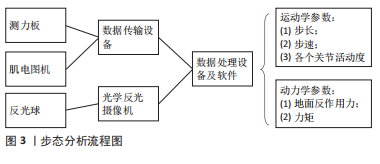
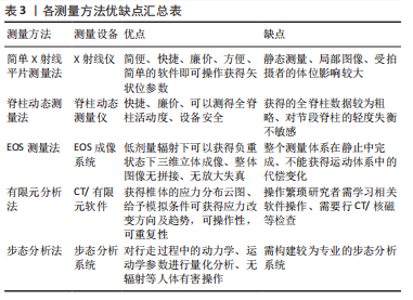
HARATO等[25]在模拟膝关节屈曲挛缩的步态分析中检查了10名健康女性,以阐明膝腰综合征,他们的研究结果表明膝关节屈曲挛缩显著影响三维躯干运动学,并会导致脊柱矢状位排列失衡。IIJIMA等[40]将步态分析应用于膝腰综合征的研究,发现在步态分析中,存在膝关节内翻应力的患者发生中到重度下腰痛的风险是对照组的3.6倍。据调查16%-31%的膝关节骨性关节炎患者存在膝关节的内翻应力[41]。这项研究强调了膝关节内翻应力和下腰痛之间的新关系,证明了此前的生物力学观点,即所谓的膝腰综合征[42-43]。SOTELO等[44]纳入24名健康的成年人进入步态分析的研究,通过护膝锁定单侧膝关节不同的屈曲角度进行分析,导出正常行走和单侧膝关节屈曲30°和60°行走时的骨盆和躯干以及下肢的运动学参数发现,在支撑相时,髋关节、膝关节屈曲角度和踝背屈角度均显著增加;在单侧膝关节屈曲角度小于30°时,骨盆和上身运动学参数没有改变,指出下肢可以完全代偿小于30°的膝关节屈曲畸形,不对称的肢体负荷将增加下肢关节长期不良反应的风险。这些发现为阐明膝骨性关节炎相关腰痛的发病机制提供了新的视角。 步态分析是伴随高科技产物不断进步、完善的研究方法,对行走中的各个过程进行量化分析,从时间、空间领域进行膝腰综合征的研究,其无辐射、无害的操作也是研究者们较为欣赏的一点。步态分析的研究是运动医学研究中极为重要的一环。综上所述,各类研究方法均有其独到之处,各测量方法优缺点可见表3。"
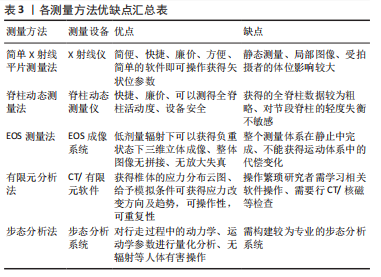
| [1] TSUJI T, MATSUYAMA Y, GOTO M, et al. Knee-spine syndrome: correlation between sacral inclination and patellofemoral joint pain. J Orthop Sci. 2002; 7(5):519-523. [2] UEHARA K, AKAI M, DOI T, et al. Relationship between X-ray findings of lumbar spondylosis and knee pain. BMC Musculoskeletal Disorders. 2019; 20(1):379. [3] BLAGOJEVIC M, JINKS C, JEFFERY A, et al. Risk factors for onset of osteoarthritis of the knee in older adults: a systematic review and meta-analysis. Osteoarthritis Cartilage. 2010;18(1):24-33. [4] BURGER H, VAN DAELE PL, ODDING E, et al. Association of radiographically evident osteoarthritis with higher bone mineral density and increased bone loss with age. The Rotterdam Study. Arthritis Rheum. 1996;39(1):81-86. [5] DAVIS MA, ETTINGER WH, NEUHAUS JM, et al. The association of knee injury and obesity with unilateral and bilateral osteoarthritis of the knee. Am J Epidemiol. 1989;130(2):278-288. [6] HART DJ, DOYLE DV, SPECTOR TD. Incidence and risk factors for radiographic knee osteoarthritis in middle-aged women: the Chingford Study. Arthritis Rheum. 1999;42(1):17-24. [7] MURAKI S, AKUNE T, OKA H, et al. Incidence and risk factors for radiographic knee osteoarthritis and knee pain in Japanese men and women: a longitudinal population-based cohort study. Arthritis Rheum. 2012;64(5):1447-1456. [8] SEKI T, HASEGAWA Y, YAMAGUCHI J, et al. Association of serum carotenoids, retinol, and tocopherols with radiographic knee osteoarthritis: possible risk factors in rural Japanese inhabitants. J Orthop Sci. 2010;15(4):477-484. [9] YUDOH K, NGUYEN V, NAKAMURA H, et al. Potential involvement of oxidative stress in cartilage senescence and development of osteoarthritis: oxidative stress induces chondrocyte telomere instability and downregulation of chondrocyte function. Arthritis Res Ther. 2005;7(2):R380-R391. [10] OFFIERSKI CM, MACNAB I. Hip-spine syndrome. Spine (Phila Pa 1976). 1983; 8(3):316-321. [11] MURATA Y, TAKAHASHI K, YAMAGATA M, et al. The knee-spine syndrome. The Journal of Bone and Joint Surgery. British Volume. 2003;85-B(1):95-99. [12] 黄健,吕厚山,白楚杰,等.膝关节骨性关节炎合并退行性变性腰椎病变全膝关节置换术后患者腰椎前凸角度与膝关节屈曲矫正度的变化[J].中国组织工程研究与临床康复,2007,11(4):722-724. [13] 郑文鑫.腰椎管狭窄手术前后CT测量椎管容积的价值研究[D].海口:海南医学院,2018. [14] 戴力杨.腰椎屈伸活动对椎管容量的影响[J].第二军医大学学报,1989, 9(3):197-199. [15] GLASSMAN SD, BRIDWELL K, DIMAR JR, et al. The impact of positive sagittal balance in adult spinal deformity. Spine (Phila Pa 1976). 2005;30(18): 2024-2029. [16] MIN K, HAHN F, LEONARDI M. Lumbar spinal osteotomy for kyphosis in ankylosing spondylitis: the significance of the whole body kyphosis angle. J Spinal Disord Tech. 2007;20(2):149-153. [17] KECHAGIAS VA, GRIVAS TB, PAPAGELOPOULOS PJ, et al. Investigation of the relationship between hip and knee osteoarthritis and disordered spinal and pelvic morphology. Cureus. 2022;14(1):e20861. [18] WANG WJ, LIU F, ZHU YW, et al. Sagittal alignment of the spine-pelvis-lower extremity axis in patients with severe knee osteoarthritis. Bone Joint Res. 2016,5(5):198-205. [19] 刘飞,王渭君,翁文杰,等.膝关节骨关节炎患者脊柱-骨盆-下肢矢状面形态变化的初步研究[J].中国矫形外科杂志,2015,23(9):784-789. [20] LEE CS, PARK SJ, CHUNG SS, et al. The effect of simulated knee flexion on sagittal spinal alignment: novel interpretation of spinopelvic alignment. Eur Spine J. 2013;22(5):1059-1065. [21] KATSUMI R, MANNEN EM, BAJAJ G, et al. The influence of knee osteoarthritis on spinopelvic alignment and global sagittal balance. J Knee Surg. 2022. doi: 10.1055/s-0042-1747947. [22] 张胜国,刘海鹰,王波,等.膝关节屈曲畸形与腰椎和骨盆矢状位对线的相关性研究[J].中国矫形外科杂志,2013,21(9):914-917. [23] TAUCHI R, IMAGAMA S, MURAMOTO A, et al. Influence of spinal imbalance on knee osteoarthritis in community-living elderly adults. Nagoya J Med Sci. 2015;77(3):329-337. [24] YANAGISAWA S, SATO N, SHIMIZU M, et al. Relation among the knee, sagittal spinal alignment, and the spinal range of motion: investigation in local medical check-ups using the Spinal Mouse. Asia Pac J Sports Med Arthrosc Rehabil Technol. 2015;2(2):68-71. [25] HARATO K, NAGURA T, MATSUMOTO H, et al. A gait analysis of simulated knee flexion contracture to elucidate knee-spine syndrome. Gait Posture. 2008;28(4):687-692. [26] IMAGAMA S, ITO Z, WAKAO N, et al. Influence of spinal sagittal alignment, body balance, muscle strength, and physical ability on falling of middle-aged and elderly males. Eur Spine J. 2013;22(6):1346-1353. [27] IMAGAMA S, MATSUYAMA Y, HASEGAWA Y, et al. Back muscle strength and spinal mobility are predictors of quality of life in middle-aged and elderly males. Eur Spine J. 2011;20(6):954-961. [28] POST RB, LEFERINK VJ. Spinal mobility: sagittal range of motion measured with the Spinal Mouse, a new non-invasive device. Arch Orthop Trauma Surg. 2004;124(3):187-192. [29] FUNAO H, TSUJI T, HOSOGANE N, et al. Comparative study of spinopelvic sagittal alignment between patients with and without degenerative spondylolisthesis. Eur Spine J. 2012;21(11):2181-2187. [30] BARREY C, ROUSSOULY P, LE HUEC JC, et al. Compensatory mechanisms contributing to keep the sagittal balance of the spine. Eur Spine J. 2013;22 Suppl 6:S834-S841. [31] 李青,翁文杰,王渭君,等.EOS成像系统的介绍及其评估下肢力线临床价值的研究现状[J].中国骨伤,2019,32(9):875-878. [32] LAZENNEC J Y, FOLINAIS D, BENDAYA S, et al. The global alignment in patients with lumbar spinal stenosis: our experience using the EOS full-body images. Eur J Orthop Surg Traumatol. 2016;26(7):713-724. [33] OBEID I, HAUGER O, AUNOBLE S, et al. Global analysis of sagittal spinal alignment in major deformities: correlation between lack of lumbar lordosis and flexion of the knee. European Spine Journal. 2011;20(S5):681-685. [34] FERRERO E, LIABAUD B, CHALLIER V, et al. Role of pelvic translation and lower-extremity compensation to maintain gravity line position in spinal deformity. J Neurosurg Spine. 2016;24(3):436-446. [35] 冯其金,赵玲娟,郑昆仑,等.有限元分析法在腰椎生物力学中的研究进展[J].中国中西医结合外科杂志,2018,24(2):255-258. [36] 吕震.膝关节退变对KLS腰椎运动单元负荷改变机制的研究[D].天津:天津医科大学,2019. [37] ADAMS MA, HUTTON WC. The effect of posture on the role of the apophysial joints in resisting intervertebral compressive forces. J Bone Joint Surg Br. 1980;62(3):358-362. [38] 周恩昌,唐萍,殷浩,等.膝内翻对骨盆─腰椎矢状位序列影响的有限元分析[J].中国骨与关节损伤杂志,2017,32(12):1233-1236. [39] 谈绎文,郑昱新,詹红生,等.三维步态分析在膝骨关节炎研究中的应用[J].国际骨科学杂志,2014,35(4):215-218. [40] IIJIMA H, SUZUKI Y, AOYAMA T, et al. Relationship between varus thrust during gait and low back pain in individuals with knee osteoarthritis. Arthritis Care Res. 2020;72(9):1231-1238. [41] CHANG A, HAYES K, DUNLOP D, et al. Thrust during ambulation and the progression of knee osteoarthritis. Arthritis Rheum. 2004;50(12):3897-3903. [42] FUKUTANI N, IIJIMA H, FUKUMOTO T, et al. Association of varus thrust with pain and stiffness and activities of daily living in patients with medial knee osteoarthritis. Phys Ther. 2016;96(2):167-175. [43] IIJIMA H, FUKUTANI N, AOYAMA T, et al. Clinical phenotype classifications based on static varus alignment and varus thrust in japanese patients with medial knee osteoarthritis. Arthritis Rheumatol. 2015;67(9):2354-2362. [44] SOTELO M, EICHELBERGER P, FURRER M, et al. Walking with an induced unilateral knee extension restriction affects lower but not upper body biomechanics in healthy adults. Gait Posture. 2018;65:182-189. [45] YASUDA T, TOGAWA D, HASEGAWA T, et al. Relationship between knee osteoarthritis and spinopelvic sagittal alignment in volunteers over 50 years of age. Asian Spine J. 2020;14(4):495-501. [46] OSHIMA Y, WATANABE N, IIZAWA N, et al. Knee–hip–spine syndrome: improvement in preoperative abnormal posture fo llowing total knee arthroplasty. Adv Orthop. 2019;2019:1-9. |
| [1] | Guo Shuhui, Yang Ye, Jiang Yangyang, Xu Jianwen. Screening and validation of neurogenic bladder miRNA-mRNA regulatory network [J]. Chinese Journal of Tissue Engineering Research, 2023, 27(在线): 1-8. |
| [2] | Fang Xingyan, Tian Zhenli, Zhao Zheyi, Wen Ping, Xie Tingting. Effects of sodium arsenite on human umbilical vein endothelial cell injury and sphingosine kinases 1/sphingosine 1-phosphate signaling axis [J]. Chinese Journal of Tissue Engineering Research, 2023, 27(在线): 1-7. |
| [3] | Zhong Yizheng, Huang Peizhen, Cai Qunbin, Zheng Liqin, He Xingpeng, Dong Hang. Microstructural indexes that determine the trabecular bone maximum stress of micro-finite element models [J]. Chinese Journal of Tissue Engineering Research, 2023, 27(9): 1313-1318. |
| [4] | Li Xiaomin, Tian Xiangdong, Tan Yetong, Zhu Guangyu, Wang Rongtian, Wang Jian, Xue Zhipeng, Ma Sheng, Hu Yuanyi, Huang Ye, Ding Tiansong. Changes of lower limb force line and knee function after high tibial osteotomy in osteoporotic medial ventricular knee osteoarthritis [J]. Chinese Journal of Tissue Engineering Research, 2023, 27(9): 1325-1329. |
| [5] | Tang Huiyu, Hou Biao, Xia Xiaodan, Xiang Wei, Xie Songlin. Effect of mechanical tension stress on arterial vessels after limb osteotomy in rabbits [J]. Chinese Journal of Tissue Engineering Research, 2023, 27(9): 1422-1426. |
| [6] | Peng Zhixin, Yan Wengang, Wang Kun, Zhang Zhenjiang. Finite element analysis and structural optimization design of 3D printed forearm braces [J]. Chinese Journal of Tissue Engineering Research, 2023, 27(9): 1340-1345. |
| [7] | Wu Tianliang, Tao Xiuxia, Xu Hongguang. Influence of different bone mineral densities on cage subsidence after stand-alone oblique lateral interbody fusion: three-dimensional finite element analysis [J]. Chinese Journal of Tissue Engineering Research, 2023, 27(9): 1352-1358. |
| [8] | Liu Jinyu, Zhang Hanshuo, Cui Hongpeng, Pan Lingzhi, Zhao Boran, Li Fei, Ding Yu. Finite element biomechanical analysis of minimally invasive treatment of cervical spondylotic myelopathy and accurate exercise rehabilitation [J]. Chinese Journal of Tissue Engineering Research, 2023, 27(9): 1359-1364. |
| [9] | He Yujie, Kang Zhijie, Xue Mingming, Jin Feng, Li Zhijun, Wang Xing, Xu Yangyang, Gao Mingjie, Li Jiawei, Li Xiaohe, Wang Haiyan. Finite element analysis of transarticular screw fixation of adolescent thoracic vertebra [J]. Chinese Journal of Tissue Engineering Research, 2023, 27(9): 1365-1370. |
| [10] | Wen Xinghua, Ding Huanwen, Cheng Kai, Yan Xiaonan, Peng Yuanhao, Wang Yuning, Liu Kang, Zhang Huiwu. Three-dimensional finite element model analysis of intramedullary nailing fixation design for large femoral defects in Beagle dogs [J]. Chinese Journal of Tissue Engineering Research, 2023, 27(9): 1371-1376. |
| [11] | Cai Zhihao, Xie Zhaoyong. Femoral neck anteversion measurement assessment: how to establish a unified method and standard [J]. Chinese Journal of Tissue Engineering Research, 2023, 27(9): 1448-1454. |
| [12] | Dang Yi, Du Chengyan, Yao Honglin, Yuan Nenghua, Cao Jin, Xiong Shan, Zhang Dingmei, Wang Xin. Hormonal osteonecrosis and oxidative stress [J]. Chinese Journal of Tissue Engineering Research, 2023, 27(9): 1469-1476. |
| [13] | Yu Wenqiang, Ren Fuchao, Shi Guohong, Xu Yuanjing, Liu Tongyou, Xie Youzhuan, Wang Jinwu, . Methods and application of gait analysis of lower limbs after stroke [J]. Chinese Journal of Tissue Engineering Research, 2023, 27(8): 1257-1263. |
| [14] | Nie Chenchen, Su Kaiqi, Gao Jing, Fan Yongfu, Ruan Xiaodi, Yuan Jie, Duan Zhaoyuan, Feng Xiaodong. The regulatory role of circular RNAs in cerebral ischemia-reperfusion injury [J]. Chinese Journal of Tissue Engineering Research, 2023, 27(8): 1286-1291. |
| [15] | Liang Jiaqi, Liu Hengxu, Yang Jinxin, Yang Yi, Deng Xuhui, Tan Mingjian, Luo Jiong. Health benefit relationship between exercise and intestinal bacteria [J]. Chinese Journal of Tissue Engineering Research, 2023, 27(8): 1292-1299. |
| Viewed | ||||||
|
Full text |
|
|||||
|
Abstract |
|
|||||
